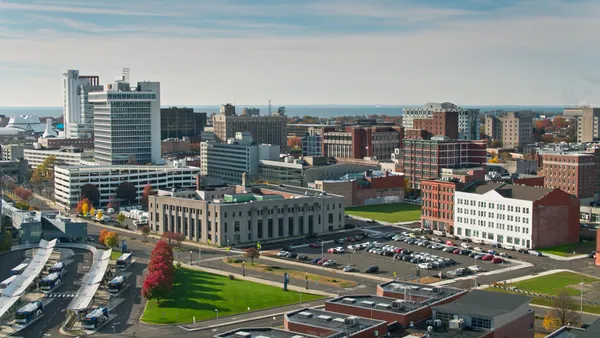Editor's Note: This is the third part of a series tracking how cities are recovering from the damages of hurricanes, like Harvey and Maria — and planning for future disasters.
While attention is starting to shift toward Hurricane Nate, San Juan, the capital of Puerto Rico, and other areas of the island are still in recovery mode from Hurricane Maria. After hitting Puerto Rico and the U.S. Virgin Islands, Maria spun north and eventually out into the Atlantic Ocean, sparing other heavily-populated areas.
A dam failure caused partial evacuations on Puerto Rico, though the entire island (population 3.4 million) was not evacuated. Because of the intensity with which Puerto Rico was hit, it's likely that relief and recovery efforts will have to continue for some time. The storm made landfall on Puerto Rico on Sept. 20, and residents are still facing dire situations. The island is still struggling with communications, so it is difficult to get a complete picture.
Smart Cities Dive has compiled a round-up of the damage sustained on Puerto Rico.
Quantifying the damaging and assessing the remediation
Health and safety
- Officials in Puerto Rico recently updated the death toll to 34, and many expect that number to grow.
- Clean water access was knocked out for large swaths of the population. Estimates as of Oct. 5 say about 45% of Puerto Ricans still lack access to clean water.
- Hospitals on the island have been thrown into crisis, operating without electricity and limited generator fuel. One report said that the medical system on the island was "on life support."
- The USNS Comfort, a hospital ship, arrived in Puerto Rico Oct. 3 to provide supplemental medical care.
Construction and transportation
- Hurricane Maria resulted in over 8,000 refugees, according to Puerto Rico's government, who are being housed in shelters across the island.
- 857 of 1,100 gas stations on the island are open, according to the latest numbers.
- Helicopters are still ferrying supplies around the island because debris hasn't been able to be cleared from all roads.
- Photos from the island show damaged roads and roads that are overrun with debris.
Waste management
- The U.S. Virgin Islands are "overwhelmed" by trash, after being hit by consecutive hurricanes.
- Lacking power and drivers to clear debris, many roads are still blocked.
- Puerto Rico already had problems with landfill capacity and coal ash dump sites, likely to be exacerbated by the hurricanes.
Energy
- About 90% of the island is still without electricity.
- Power lines are down across Puerto Rico, and officials say it will be months before power is restored.
- The Army Corps of Engineers is overseeing power and distribution projects on the island.
Communication
- Over 90% of the island lost cellphone service following the storm because of damaged antenna towers and damaged power lines.
- Just over 13% of the island's cell towers have been restored, according to Puerto Rico's government.
- Officials estimate that less than half of the island has any kind of cell or internet access.
Where do we go from here?
Between downed power lines, damaged roads and flooding, the island faces a long road to recovery. Many people, it appears, are fleeing the island, unsure of when they would be able to return home. One estimate puts the economic damage that Puerto Rico is facing at $30 billion.
If it weren't clear before, it should be now: Cities and governments need resiliency strategies. While new technologies, like nanogrids or Powerwall batteries, are promising, those sorts of technologies on their own aren't enough — they need to be a part of a broad strategy. City leaders need to have plans in place to protect lives and ensure vital operations when disaster strikes. Flood plains need to be re-mapped and adjusted for rising sea levels and intensifying storms. Power grids need to be hardened or decentralized to avoid widespread, devastating blackouts. Cities need to maintain logistics during natural or manmade disruptions. While every city will have different needs, there are organizations that help cities develop strategies and action plans to become more resilient. The planning can be complicated, and involve countless stakeholders and consultants, but it is critical.
Smart cities can no longer afford to feel satisfied by having an open data policy and data about traffic patterns. The smartest cities must be ready for disaster to proactively protect lives and property, not just react once the flood waters are already rising.












